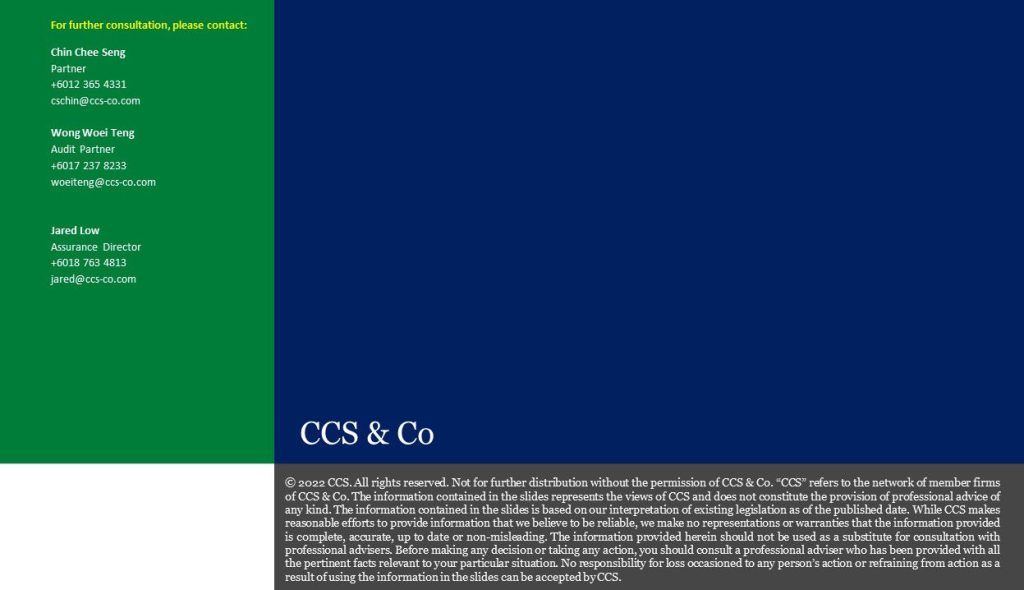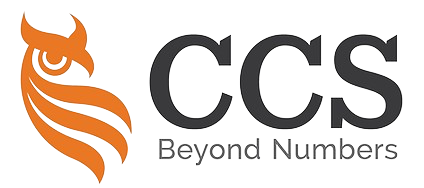Latest Update: 16-5-2022
1. The Employment (Amendment) Bill 2021 (“the Bill”) was presented on October 25, 2021.
2. Dewan Rakyat approved the Employment (Amendment) Bill 2021 on March 21, 2022.
3. Dewan Negara passed the Employment (Amendment) Bill 2021 on March 30, 2022.
4. The Employment (Amendment) Act 2022 was gazetted into law on May 10, 2022.
However, [As of 16-5-2022] the Act has not yet come into force.
[In force means that the Act or the secondary legislation has the force of law.]
1. 《2021年就业(修订)法案》(”法案”)于2021年10月25日在国会提交。
2. 下议院于2022年3月21日批准了《2021年就业(修订)法案》。
3. 上议院于2022年3月30日也通过了《2021年就业(修订)法案》。
4. 作为立法,2022年5月10日,《2022年就业(修正)法案》在宪报上颁布。
然而请注意,[截至2022年5月16日] 此法尚未生效
[生效是指该法或次级立法具有法律效力]。
Source: ILO Discrimination in employment and occupation: general description and bases for discrimination
Question: What does the term “discrimination in employment and occupation” mean?
Answer: “Discrimination in employment and occupation” refers to practices that have the effect of placing certain individuals in a position of subordination or disadvantage in the labour market or the workplace because of their race, colour, religion, sex, political opinion, national extraction, social origin or any other attribute which bears no relation to the job to be performed.
Discriminatory practices can be direct or indirect. Direct discrimination arises when an explicit distinction, preference or exclusion is made on one or more grounds. For example, a job advertisement for “men only” would constitute direct discrimination.
Indirect discrimination refers to situations, measures or practices that are apparently neutral but which in fact have a negative impact on persons from a certain group. The latter type of discrimination, because of its more hidden nature, is the most difficult to tackle.
Equality of opportunity and treatment allows all individuals to fully develop their talents and skills according to their aspirations and preferences, and to enjoy equal access to employment as well as equal working conditions. To achieve full freedom from discrimination in employment and occupation, the mere removal of discriminatory practices does not suffice. It is also necessary to promote equality of opportunity and treatment in the workplace at all stages of the employment relationship, including recruitment, retention, promotion and termination practices, remuneration, access to vocational training, and skills development.
问: “就业和职业歧视 “一词是什么意思?
答:”就业和职业歧视 “是指在劳动力市场或工作中使某些人处于从属或不利地位的做法。”就业和职业歧视 “是指由于种族、肤色、宗教、性别、政治观点、民族血统、社会出身或与所从事工作无关的任何其他属性,使某些人在劳动力市场或工作场所处于从属或不利地位的做法。
歧视性做法可以是直接或间接的。当基于一个或多个理由做出明确的区分、偏爱或排斥时,就会产生直接歧视。例如,”只招男性 “的招聘广告就构成了直接歧视。
间接歧视是指表面上是中性的,但实际上对某一群体的人有负面影响的情况、措施或做法。后一种类型的歧视,由于其更隐蔽的性质,是最难解决的。
机会和待遇的平等使所有的人都能根据自己的愿望和偏好充分发展自己的才能和技能,并享有平等的就业机会和平等的工作条件。
为了实现在就业和职业方面完全没有歧视,仅仅消除歧视性做法是不够的。还必须在就业关系的所有阶段促进工作场所的机会和待遇平等,包括招聘、保留、晋升和解雇做法、薪酬、获得职业培训和技能发展。

Question: What are the prohibited bases of discrimination in employment?
Answer: Bases of discrimination identified and prohibited in various International Labour Standards[1] include:
Distinctions based on race and/or colour are largely rooted in social and economic factors that do not have any objective basis. They commonly involve discrimination against an ethnic group or indigenous or tribal population.
Sex discrimination includes distinctions made on the basis of biological characteristics and functions that distinguish men and women, and on the basis of social differences between men and women.
Physical distinctions include any job specifications which are not essential to carry out the prescribed duties, e.g., minimum height or weight requirements which do not impact job performance.
Social distinctions include civil status, marital status, family situation, and maternity[2].
Women are most commonly affected by discrimination based on sex, especially in the case of indirect discrimination.
Religious discrimination includes distinctions made on the basis of the expression of religious beliefs or membership in a religious group.
This also includes discrimination against people who do not ascribe to a particular religious belief or are atheists.
Although discrimination on the basis of religious beliefs should not be permitted, there may be legitimate bases for imposing requirements in the workplace which restrict the worker’s freedom to practice a particular religion.
For instance, a religion may prohibit work on a day different from the day of rest established by law or custom; a religion may require a special type of clothing that may not be compatible with safety equipment; a religion may prescribe dietary restrictions or daily routines during work hours which may be difficult for the establishment to fully accommodate, or an employment position may require an oath incompatible with a religious belief or practice.
In these cases, the worker’s right to practice fully his or her faith or belief at the workplace needs to be weighed against the need to meet genuine requirements inherent in the job or operational requirements.
Discrimination based on political opinion includes membership in a political party; expressed political, socio-political, or moral attitudes; or civic commitment.
Workers should be protected against discrimination in employment based on activities expressing their political views, but this protection does not extend to politically motivated acts of violence.
National extraction includes distinctions made on the basis of a person’s place of birth, ancestry, or foreign origin; for instance, national or linguistic minorities, nationals who have acquired their citizenship by naturalization, and/or descendants of foreign immigrants.
Social origin includes social class, socio-occupational category, and caste. The social origin may be used to deny certain groups of people access to various categories of jobs or limit them to certain types of activities.
Discrimination based on social origin denies the victim the possibility to move from one class or social category to another.
For instance, in some parts of the world, certain “castes” are considered to be inferior and therefore confined to the most menial jobs.
Age is also a prohibited basis for discrimination. Older workers are often liable to encounter difficulties in employment and occupation because of prejudices about their capacities and willingness to learn; a tendency to discount their experiences; and market pressures to hire younger workers who are often cheaper to employ[3].
Younger workers under the age of 25 may also face discrimination.
Biased treatment against younger workers can take many forms, including overrepresentation in casual jobs with lower benefits, training opportunities, and career prospects; payment of lower entry wages even in low skilled jobs where such a wage differential is difficult to justify on grounds of lower productivity; and longer probation periods and much greater reliance on flexible forms of contract[4].
HIV/AIDS status: Persons living with HIV/AIDS often suffer discrimination in the workplace and in the community. There should be no discrimination or stigmatization of workers on the basis of real or perceived HIV status.
HIV/AIDS screening should not be required of job applicants or persons in employment. HIV infection is not a valid ground for termination of employment. Persons with HIV-related illnesses should be able to work for as long as medically fit under inappropriate conditions[5].
Disability: Worldwide, approximately 800 million people of working age have a disability. While many are successfully employed and fully integrated into society, as a group, persons with disabilities often face disproportionate poverty and unemployment. In this context, non-discrimination also includes taking positive steps where feasible to accommodate particular workplace needs that workers with disabilities may have[6].
Sexual orientation: Men and women workers may suffer from discrimination if they are known or believed to be lesbian, gay, bisexual or transgender; and may be subjected to verbal, psychological and physical intimidation or violence from the employer, supervisor or other workers[7].
Workers with family responsibilities: Current trends in working time in industrialized, developing and transition economies alike are putting increased pressure on workers with family responsibilities. “Family responsibilities” includes care of children and any other dependents[8].
The definition of persons constituting “family” may be broad and could be formulated after consultation with the workers concerned or their representatives. Workers who have family responsibilities are often discriminated against in hiring, job assignment, access to training, and promotion.
Enterprises should avoid discriminating against workers with family responsibilities. While having regard to operational needs, enterprises are encouraged to avoid excessively long hours, unpredictable over time that makes it difficult to plan for the care of family members and schedule work on traditional days of rest.
Trade union membership or activities: All workers have the right to form and join trade unions, and to participate as members or leaders in trade union activities[9] and should not be discriminated against for lawfully exercising this right.
Other bases: More generally, discrimination at work includes any “distinction, exclusion or preference … which has the effect of nullifying or impairing equality of opportunity or treatment in employment or occupation.”[10]
Workers should be selected only on the basis of their ability to do the job. Enterprises are encouraged to review their hiring and other employment practices for potential bases of discrimination which may result in treating some jobseekers or workers less favorably than others because of characteristics that are not related to the person’s competencies or the inherent requirements of the job.
[1] Discrimination (Employment and Occupation) Convention, 1958 (No. 111), Article 1(a). [2] For further details see Maternity Protection Convention, 2000 (No. 183) and Recommendation (No. 191) ; and Workers with Family Responsibilities Convention, 1981 (No. 156) and Recommendation (No. 165). [3] Older Workers Recommendation, 1980 (No. 162). [4] Equality at work: tackling the challenges. Global report under the follow-up to the ILO Declaration on Fundamental Principles and Rights at Work, ILO, Geneva, 2007. See, page 38. [5] ILO Code of Practice on HIV/AIDS and the World of Work [6] Vocational Rehabilitation and Employment (Disabled Persons) Convention (No. 159) and Recommendation (No. 168); United Nations Convention on the Rights of Persons with Disabilities [7] Equality at work: Tackling the challenges, pages 42-43. [8] Equality at work: Tackling the challenges, page 77. [9] Freedom of Association and Protection of the Right to Organise Convention, 1948 (No. 87), Article 2; Right to Organise and Collective Bargaining Convention, 1949 (No. 98), Article 1 [10] Discrimination (Employment and Occupation) Convention, 1958 (No. 111), Article 1(b) .
问: 在就业方面有哪些被禁止的歧视依据?
答: 各种国际劳工标准[1]确定和禁止的歧视基础包括:
基于种族和/或肤色的区分主要源于社会和经济因素,没有任何客观依据。它们通常涉及对某一族裔群体或土著或部落人口的歧视。
性别歧视包括根据区分男女的生物特征和功能进行的区分;以及根据男女之间的社会差异进行的区分。
身体上的区别包括任何不是履行规定职责所必需的工作规格,例如,不影响工作表现的最低身高或体重要求。社会差别包括公民身份、婚姻状况、家庭状况和产假[2] 。
妇女最常受到基于性别的歧视的影响,特别是在间接歧视的情况下。
宗教歧视包括基于宗教信仰的表达或宗教团体成员身份的区别对待。
这也包括对不信奉某种宗教信仰或无神论者的歧视。
虽然不应允许基于宗教信仰的歧视,但在工作场所提出限制工人信奉特定宗教的自由的要求,可能有合法的依据。
例如,一种宗教可能禁止在与法律或习俗规定的休息日不同的日子工作;一种宗教可能要求一种特殊类型的服装,而这种服装可能与安全设备不相容;一种宗教可能规定饮食限制或工作时间的日常生活习惯,而这可能是机构难以完全适应的;或者一个就业职位可能要求进行与宗教信仰或实践不相容的宣誓。
在这些情况下,工人在工作场所充分实践其信仰或信念的权利需要与满足工作中固有的真正要求或业务要求的需要进行权衡。
基于政治观点的歧视包括加入某个政党;表达的政治、社会政治或道德态度;或公民承诺。
应保护工人不因表达政治观点的活动而受到就业歧视;但这种保护不包括出于政治动机的暴力行为。
民族血统包括根据一个人的出生地、血统或外国血统进行的区分;例如,民族或语言上的少数群体、通过归化获得公民身份的国民和/或外国移民的后代。
社会出身包括社会阶层、社会职业类别和种姓。社会出身可能被用来剥夺某些群体获得各类工作的机会,或限制他们从事某些类型的活动。
基于社会出身的歧视剥夺了受害者从一个阶层或社会类别转移到另一个阶层或社会类别的可能性。
例如,在世界的某些地方,某些 “种姓”被认为是低等的,因此被限制在最卑微的工作上。
年龄也是一个被禁止的歧视依据。
老年工人往往容易在就业和职业方面遇到困难,因为人们对他们的能力和学习意愿存在偏见;对他们的经验有打折扣的倾向;以及市场压力要求雇用年轻工人,因为他们的雇用成本往往较低[3] 。
25岁以下的年轻工人也可能面临歧视。
对年轻工人的偏见待遇有多种形式,包括在福利、培训机会和职业前景较差的临时工作中占比过高;即使在低技能工作中也支付较低的起薪,而这种工资差异很难以较低的生产率为理由;更长的试用期和对灵活合同形式的更大依赖[4] 。
艾滋病毒/艾滋病状况。
艾滋病患者经常在工作场所和社区受到歧视。
不应基于实际或感知的HIV状况对工人进行歧视或污名化。不应要求求职者或在职者进行艾滋病毒/艾滋病筛查。
艾滋病感染不是终止就业的有效理由。患有HIV相关疾病的人应该能够在适当的条件下工作,只要身体健康就可以了[5]。
残疾
在世界范围内,大约有8亿工作年龄的人有残疾。
虽然许多人成功就业并完全融入社会,但作为一个群体,残疾人往往面临着不成比例的贫困和失业。
在这种情况下,非歧视还包括在可行的情况下采取积极措施,以满足残疾工人的特殊工作场所需求。

Question: We found during a supplier audit that the employment contracts with employees contain the following clause: “Company retains the right to transfer the employees upfront.” Is this consistent with your standards?
Answer: The Workers with Family Responsibilities Recommendation, 1981 (No. 165) sets out in paragraph 20 the principle that “Family responsibilities and considerations such as the place of employment of the spouse and the possibilities of educating children should be taken into account when transferring workers from one locality to another.” The idea is to encourage a balanced approach between the needs of the enterprise and the needs of the worker’s/manager’s family. The enterprise should be encouraged to take family responsibilities into account to a reasonable extent when reassigning managers to new duty stations.

Question: Is there any distinction that is not considered discriminatory?
Answer: Distinctions based on skills or efforts are legitimate.
Disparities in remuneration that reflect differences in years of education or the number of hours worked are acceptable.
Enterprise compliance with government policies designed to correct historical patterns of discrimination and thereby extend equality of opportunity and treatment in employment does not constitute discrimination.
Special measures of protection or assistance provided by national law, such as the ones concerning health and maternity, are also important provisions that do not constitute discrimination.
Giving effect to the principle of equal treatment may require special measures and the accommodation of differences, for instance concerning people with disabilities.
问: 是否有任何区别不被认为是歧视性的?
答: 基于技能或努力的区分是合法的。
反映受教育年限或工作时间的差异的薪酬差异是可以接受的。
企业遵守政府的政策,旨在纠正历史上的歧视模式,从而扩大就业中的机会和待遇平等,并不构成歧视。
国家法律规定的特殊保护或援助措施,如有关健康和生育的措施,也是不构成歧视的重要规定。
落实平等待遇原则可能需要采取特别措施和照顾差异,例如有关残疾人的措施。

Question: Where can discrimination occur in the workplace?
Answer: Discrimination may occur before hiring, on the job, or upon leaving. At the enterprise level, it can occur in the following areas:
- recruitment
- remuneration
- entitlements
- hours of work and rest
- paid holidays
- maternity protection
- security of tenure
- job assignments
- performance assessment and promotion
- training opportunities
- job prospects
- occupational safety and health
- termination of employment. [1]
Discrimination does not have to be intentional and often managers and workers in a company are surprised at discriminatory practices they uncover when they start to look for them.
Discrimination can be direct or indirect. Indirect discrimination refers to apparently neutral practices that in fact result in unequal treatment of people with certain characteristics[2].
For instance, organizing training courses after work late in the day may exclude workers who may be interested in attending them but cannot do so because of their family responsibilities. Workers who receive less training are likely to be disadvantaged in subsequent job assignments and promotion prospect.
[1] Recommendation No.111 Discrimination (Employment and Occupation) Recommendation, 1958 [2] ILO, ABC of Women worker’s rights and gender equality, 2nd Edition. Geneva 2007
问: 在工作场所哪些地方会发生歧视?
答: 歧视可能发生在雇用前、工作中或离开时。
在企业层面,它可能发生在以下几个方面:-
- 招聘
- 薪酬
- 应享权利
- 工作时间和休息时间
- 带薪假期
- 产妇保护
- 任职保障
- 工作分配
- 绩效评估和晋升
- 培训机会
- 工作前景
- 职业安全和健康
- 终止雇用。[1]
歧视不一定是故意的,公司的经理和工人在开始寻找歧视性做法时,往往会对他们发现的歧视性做法感到惊讶。
歧视可以是直接或间接的。间接歧视指的是表面上中立的做法,实际上导致了对具有某些特征的人的不平等待遇[2]。
例如,在下班后很晚的时候组织培训课程,可能会把那些可能有兴趣参加培训但因家庭责任而无法参加的工人排除在外。接受培训较少的工人很可能在随后的工作分配和晋升前景方面处于不利地位。
[1] 1958年第111号建议:歧视(就业和职业)建议。
[2] 国际劳工组织,《女工权利和性别平等ABC》,第二版。日内瓦,2007年
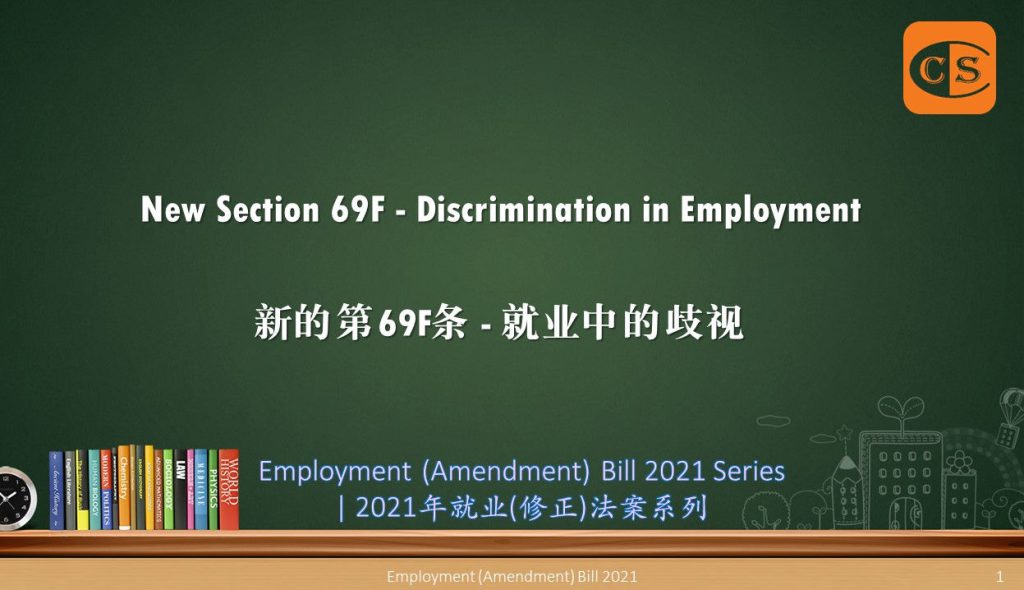
1. Some of the most significant amendments suggested to the Employment Act 1955 as a result of the Employment (Amendment) Bill 2021 (“the Bill”) include New Section 69F – Discrimination in Employment
2. With the Amendments, the Director-General would be given the authority to investigate and make a decision or an order on any disagreement between an employee and his or her employer about any issue relating to discrimination in the workplace.
🌻🌻🌻🌻🌻🌻🌻🌻
1. 2021年劳工(修正)法案对1955年劳工法令提出的一些重要修正,包括新的第69F条 — 就业中的歧视 2. 根据拟议的法案,总监被授权对雇员和其雇主之间关于工作场所歧视问题的任何分歧进行调查并作出决定或命令。雇主如果不遵守因歧视而发出的任何命令,则被视为是一项罪行。

3. An employer’s failure to comply with any order issued as a result of the disagreement is considered a violation of the law.
👉 When a company is found guilty, the company will be subject to a fine not exceeding RM50,000.
👉 A daily fine of not more than RM1,000 per day for each day the offence continues after conviction
4. The wording of the amending legislation appears to be very broad at this stage, and it would appear that a complaint might be filed against various discriminatory acts in the workplace under its provisions. 5. For example, these may include not just discrimination based on colour, gender, or disability. Still, they may also involve discrimination in selecting employees, the approval of leave applications, and other forms of employment discrimination. 6. It is uncertain if they may be extended to cover job seekers, even though, ostensibly, job applicants are not employees and hence should not be subject to any investigation or investigation of them. 7. It remains to be seen whether the Malaysian courts will interpret these provisions narrowly or broadly, as they may have a material impact on businesses if the Director-General is permitted to substitute business management decisions with those made by the Director-General on the pretext of discriminatory practises, as has happened in the past in other countries.
8. Facebook Live 👉 https://lnkd.in/eMKwGYzD [Mandarin]
9. Join our Telegram – https://t.me/YourAuditor
3. 当公司被认定有罪时,一旦定罪:
👉 将被处以不超过 50 千令吉的罚款。 👉 若从犯,每天将被处以不超过 1 千令吉的罚款 4. 现有的阶段看来,修订法的措辞很宽泛,根据其规定,似乎可以对工作场所的各种歧视性行为提出投诉。 5. 例如,这些可能不仅包括基于肤色、性别或残疾的歧视。但是,它们也可能涉及在选择雇员、批准休假申请和其他形式的就业歧视。 6. 不确定的是,它们是否可以扩展到求职者,尽管从表面上看,求职者不是雇员,因此不应受到任何调查或调查他们。 7. 马来西亚法庭对这些规定的解释是狭义的还是宽泛的,还有待观察,因为如果允许总监以歧视性做法为借口取代企业管理决定,那么这些条款可能会对企业产生实质性的影响,就像过去在其他国家发生的那样。 8. Facebook Live 👉 https://lnkd.in/eMKwGYzD 9. 加入 Telegram – https://t.me/YourAuditor
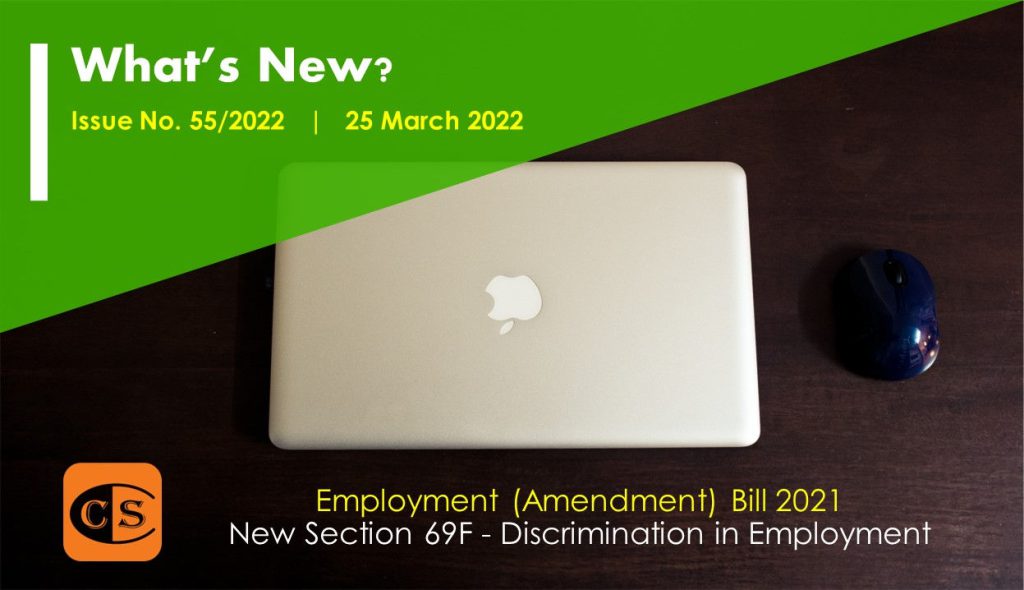
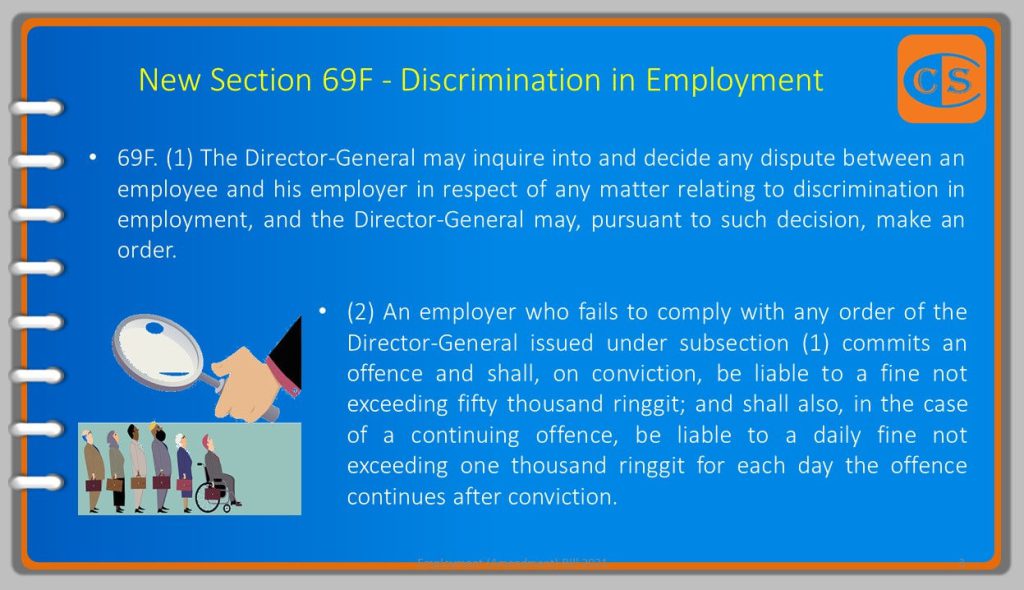


🌼🌼🌼🌼🌼🌼🌼🌼🌼🌼
Employment (Amendment) Bill 2021 Series 2021年劳工(修正)法案系列
1. Amendment of Section 2 – Interpretation [对第2条文的修正 – 定义] https://lnkd.in/eRjMe_Ha / https://lnkd.in/eGz7Z9Dx
2. Amendment of Section 4 – Appeals [对第4条文的修正 – 上诉] https://lnkd.in/eP82B7WQ / https://lnkd.in/eEUfudPU
3. – Amendment of Section 18A – Calculation of Wages for Incomplete Month’s Work [对第18A条文的修正 – 服务未满整个月的工资计算方法] https://lnkd.in/epj-4VjE / https://lnkd.in/er9JzqCU
4. Amendment of Section 22 – Limitation on Advances to Employees [对第22条文的修正 – 对雇员预支薪水的限制] https://lnkd.in/emKmjpWe / https://lnkd.in/eTVDFdH7
5. Amendment of Section 25 – Wages to be Paid through Financial Institution [对第25条文的修正 – 通过金融机构支付工资] https://lnkd.in/eB_XgrCF / https://lnkd.in/e6WfJ2yg
6. Amendment of Section 25A – Payment of Wages other than through Financial Institution [对第25A条文的修正 – 通过金融机构以外的方式支付工资] https://lnkd.in/eUJMRs9R / https://lnkd.in/e3PhUw37
7. Amendment of Section 33A – Information Relating to Supply of Employees [对第33A条文的修正 – 与雇员供应有关的信息] https://lnkd.in/eGFCfPZW / https://lnkd.in/ebCtvCu9
8. Deletion of Part VIII on the prohibition on employing women in night work, underground work [ 删除第八部分关于女性从事夜间工作、地下工作等的任何禁止] https://lnkd.in/e3ktX8xi / https://lnkd.in/ee_i3eD7
9. Amendment of Section 37- Length of Eligible Period and Entitlement to Maternity Allowance [第37条的修订 – 符合条件的时间长度和享受产假津贴的权利] https://lnkd.in/exxNvppY / https://lnkd.in/e6hiidfN
10. New Section 41A – Restriction on Termination of Pregnant Female Employee [新的第41A条 – 对终止怀孕女雇员雇佣合约的限制] https://lnkd.in/e75Y3WRY / https://lnkd.in/eZs76yAr
11. Amendment of Section 42- Restriction on Termination of Female Employee After Eligible Period [第42条的修订 – 对女性雇员在合格期限后 被终止合约的限制] https://lnkd.in/edk6mNSu / https://lnkd.in/ezfke64k
12. Deletion of Section 44A – Application of this Part Irrespective of Wages of Female Employee [删除第44A条 – 无论女雇员的工资如何,本部分都适用] https://lnkd.in/eUbtB5ia / https://lnkd.in/egngtPPf
13. Amendment of Section 57 – Termination of Contract [第57条的修订 — 合同的终止] https://lnkd.in/eFabDdsA / https://lnkd.in/ensjPPJJ
14. Amendment of Section 57A – Employment of Foreign Domestic Employee [第57A条的修订 — 外籍家庭雇员的雇用]’ https://lnkd.in/eNfhVrUC / https://lnkd.in/e94QMAZB
15. Amendment of Section 57B – Duty to inform Director-General of Termination of Service of Foreign Domestic Employee [第57B条的修订 – 通知总监终止外籍家庭雇员服务的义务] https://lnkd.in/eFyc27Wn / https://lnkd.in/eeggM_AN
16. Amendment of Section 60A – Hours of Work and Working at Night [第60A条的修订 – 工作时间每周48改成45小时和夜间工作] https://lnkd.in/eHJwU4T5 / https://lnkd.in/eMaDPbtX 17. Amendment of Section 60C – Shift Work [第60C条的修订 — 轮班工作] https://lnkd.in/eRwwe6ie / https://lnkd.in/ev42tQky
18. Amendment of Section 60F – Sick Leave [第60F条的修订 – 病假] https://lnkd.in/ektGrFZa / https://lnkd.in/euJUaheG
19. New Section 60FA – 7-day Paternity Leave [新的第60FA条 – 7天陪产假] https://lnkd.in/e4jNjTdv / https://lnkd.in/ertbkK65
20. Substitution of Section 60k – Employment of Foreign Employee [取代第60K条 – 外国雇员的雇用] https://lnkd.in/e_YEsZJD / https://lnkd.in/e_YEsZJD
21. New Section 60KA – Termination of Employment of Foreign Employee, etc. [新的第60KA条 – 外国雇员的终止雇用等等] https://lnkd.in/ebBbEQFR / https://lnkd.in/ejCpzEmb
22. Deletion of Section 60L – Director-General may inquire into Complaint [删除第60L条 – 总监可对投诉进行调查] https://lnkd.in/eiG7iSP8 / https://lnkd.in/eYjZDYSy
23. New Part XIIC – Flexible Working Arrangement [新的第XIIC部分 – 弹性工作安排] https://lnkd.in/ewW8gxqi / https://lnkd.in/e-5CYfr6
24. Amendment of Section 69 – Director General’s Power to Inquire into Complaints [第69条的修订 – 总监调查投诉的权力] https://lnkd.in/eDwVsqPw / https://lnkd.in/e97eY-fw
25. Deletion of Sections 69B, 69C, 69D and 69E [删除第69B、69c、69D和69E条] https://lnkd.in/ek-T48M7 / https://lnkd.in/eu9BRFBF 25. New Section 69F – Discrimination in Employment [新的第69F条 — 就业中的歧视 ] https://lnkd.in/e6_-G8rZ / https://lnkd.in/eVjS9Q7S
26. Amendment of Section 70 – Procedure in Director General’s Inquiry [第70条的修订 – 总监调查的程序] https://lnkd.in/e6_-G8rZ / https://lnkd.in/eVjS9Q7S
27. Amendment of Section 73 – Prohibitory Order by Director General to Third Party [第73条的修订 – 总监向第三方发出的禁止令] https://lnkd.in/e6_-G8rZ / https://lnkd.in/eVjS9Q7S
28. Amendment of Section 77 – Appeal Against Director General’s Order to High Court [对第77条的修订 – 对总监的命令向高庭提出上诉] https://lnkd.in/eqZbmb_h / https://lnkd.in/eEbjDkc3
29. Amendment of Section 81F – Offence [第81F条的修订 – 罪行] https://lnkd.in/eqZbmb_h / https://lnkd.in/eEbjDkc3
30. Deletion of Section 81G – Application of this Part [Sexual Harassment] Irrespective of Wages of Employee [删除第81G条 – 无论雇员的工资如何, 本部分 [性骚扰] 都适用] https://lnkd.in/eTsj62rE / https://lnkd.in/eJQFdzx7
31. New Section 81H – Notice on Sexual Harassment [新的第81H条 – 关于性骚扰的告示牌] https://lnkd.in/ejyK7uCB / https://lnkd.in/eP8GYYNT
32. Amendment of Section 82 – Service of Summons [第82条的修订 – 传票的送达] https://lnkd.in/eGMUvfca / https://lnkd.in/e22hZMhN
33. Amendment of Section 84 – Jurisdiction [第84条的修订 – 管辖权] https://lnkd.in/eG-BXhAi / https://lnkd.in/e_gTbnbT
34. Amendment of Section 86 – Saving clause as to Civil Jurisdiction of Courts [第86条的修订 – 关于法院民事管辖权的保留条款] https://lnkd.in/es6Qjq-A / https://lnkd.in/eHaCZbBK
35. New Section 87A – Court Order for Payments due to Employee [新的第87A条 – 法院命令向雇员支付应付款项] https://lnkd.in/eTGFdrP6 / https://lnkd.in/eJ9ZRA4E
36. New Section 90B – Forced Labour [新的第90B条 – 强迫劳动] https://lnkd.in/e_JXjVxf / https://lnkd.in/eq-VRqWU
37. Deletion of Section 93 – Offences and Penalties Under Part VIII [删除第93条 – 第八部分规定的罪行和处罚] https://lnkd.in/eDu2qZeK / https://lnkd.in/ebPvZFP9
38. Amendment of Section 99A – General Penalty [第99A条的修订 – 一般处罚] https://lnkd.in/euzRGshx / https://lnkd.in/ena5j6ZB
39. New Section 101C – Presumption as to Who is an Employee and Employer [新条款101C – 关于谁是雇员和雇主的推定] https://lnkd.in/e2KX3QiB / https://lnkd.in/eFHjknmX
40. Amendment of Section 102 – Regulations [第102条的修订 – 条例] https://lnkd.in/e8UxFucD / https://lnkd.in/e8PVAmeH
41. Saving and Transitional [节约条款及过渡性] https://lnkd.in/ehife2BB / https://lnkd.in/ekQAtgmJ
🌳🌳🌳🌳🌳🌳🌳🌳🌳🌳🌳🌳
👉 Stay in touch with us
1. Website ✍️ https://www.ccs-co.com/ 2. Telegram ✍️ http://bit.ly/YourAuditor 3. Instagram ✍ http://tiny.cc/rojzrz 4. Blog ✍ https://lnkd.in/e-Pu8_G 5. Google ✍ https://lnkd.in/ehZE6mxy
